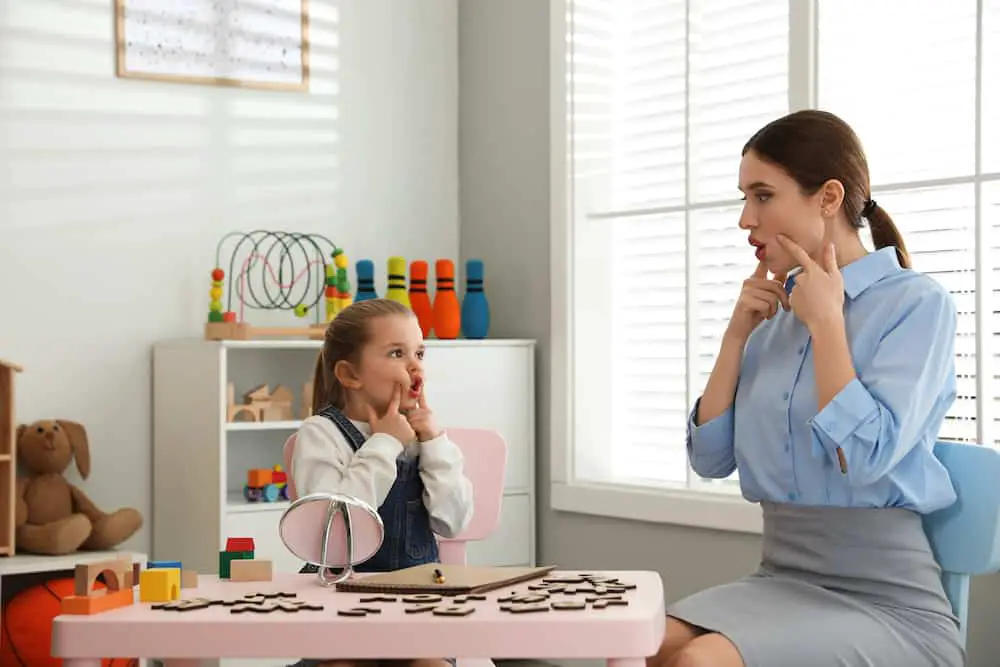Wondering how many speech therapy sessions per week your kid needs?
Unfortunately, this isn’t as straightforward to answer as most parents would like.
Your child’s speech-language pathologist will have to consider many factors, and the answer will likely depend on your child’s specific condition.
Where To Get Speech Therapy
Before you can figure out how often speech therapy should be, you first have to learn where the sessions usually occur.
There are many possible reasons a child may need speech therapy.
Depending on the circumstances, such as severity, budget, and convenience, you can opt for speech services in various locations.
Also, you will most likely receive suggestions on where to get treatment when you obtain a language disorder diagnosis for your child.
Listed below are two core settings you can expect for speech therapy:
School
In a school setup, a lot of factors will determine the type of care your kid receives.
These include your child’s age, the identified speech problem, any learning impairments or disabilities, the school’s structure, and more.
Push-in and pull-out services are the two primary types of speech therapy in schools, but how do they differ from one another?
Push-In Therapy Services
This setup lets your child learn and grow in the classroom and improve their communication skills.
Activities for push-in therapy services may include:
- Collaborating with the children in classroom discussions with adequate volume control
- Interacting and speaking with each child during a question-and-answer section of the lessons
- Adapting and evaluating the children’s ability to take information if they are having difficulties with a specific activity
- Ensuring that the children in the class don’t feel much pressure during speaking sessions
- Monitoring the progress of children’s understanding of language and being ready to assist those who need more attention
Pull-Out Therapy Services
In some situations, children might have severe language impairment or other disorders.
For more serious issues, pull-out services are more suitable and are either conducted individually or via small groups.
Students who are in pull-out therapy services will get more focused lessons, tools, and attention.
Generally, children who are in this setup have:
- Autism or cerebral palsy
- Require to have assistive devices to learn
- Multiple impairments not limited to speech, such as hearing and vision loss
- Swallowing disorders
Combination
A combination of push-in and pull-out therapy services may yield exceptional development for some children.
This setup is possible by a joint effort between parents, teachers, SLPs, and school administrators.
By working together, analyzing homework requirements and challenges will result in an effective IEP or Individualized Education Program.
Private Practice
Many SLPs offer their services via private practice.
You can check ad postings or use your preferred search engine to look up some of them.
These SLPs are able to work beyond school hours, which could be beneficial if you want them to tutor your kid privately.
SLPs who are not bound to school regulations might have techniques to speed up your child’s development further.
Let’s determine how private practice differs from school and see why some parents prefer the former.
Freedom of Schedule and Tasks
In private therapy, SLPs are not obligated to do other paperwork, which allows them to be more focused and detailed in outlining individualized treatment plans.
Since there are no school rules, SLPs have the option to start working with children immediately.
Plus, all the free time allows the speech therapist to dedicate the majority of his working hours to treating patients.
In a school-based setup, the paperwork could consume a lot of precious time.

More Personalized Treatment
Many parents think that 30 minutes of speech therapy sessions per week is sufficient to treat toddlers with speech and language disorders.
However, that short time is not enough in the majority of the cases.
SLPs have to balance time between weekly progress evaluations, review of strategies, and actual treatment of many students in a school-based therapy setup.
Considering these different tasks, it’s almost impossible to provide the necessary time and effort to the children who need regular speech therapy treatment.
Private practice SLPs have the option to regulate the number of children they can treat.
This advantage gives them more flexibility to focus on those who need more attention than others.
While school SLPs also provide individual monitoring and treatment, private practice SLPs can do it more efficiently.
Faster Progress
More often than not, children have a better rate of progress when they are in private practice speech therapy.
Besides the treatment, the parent’s involvement is more emphasized.
They get updated every week and are also given numerous tips on how to help their children.
A school-based setup might offer this level of engagement, but consistency is something it couldn’t promise.
Private practice SLPs could cater to each child for about 45 minutes.
In contrast, school SLPs might only allow up to a maximum of 30 minutes per session.
Because of the extra time, more attention is guaranteed.
SLPs in private practice can observe behaviors more, better assess progress consistently, and recalibrate the treatment techniques more easily.
How Many Speech Therapy Sessions Per Week Is Recommended?
The short answer is that it varies because you have to factor in the setup, the strategy implemented, and who is helping you.
Regardless of the unique characteristics of students, research shows that SLPs prefer to have one scheduling choice and apply this throughout their whole workload.
For example, many school SLPs mainly give services two to three times a week in pull-out therapy sessions.
Some believe that this is because of the habits and the massive number of caseloads.
Others think it is an IEP culture, or it is the way education systems are constructed.
However, notwithstanding the cause, a weekly therapy for school-based SLPs usually lasts for about 20 to 30 minutes.
These numbers are also applicable for private practice SLPs, though it’s safe to assume that the results could be more impressive.
In some intense SLP programs, parents are offered 30 hours of treatment per month.
This means the child must attend at least one hour every day for a month to overcome language disorder.
However, this aggressive scheduling could take a toll on children who have attention issues.
Scheduling Options
SLPs might have variations in scheduling, but the usual session patterns may include:
Traditional
Followed by many SLPs, weekly therapy has a consistent number of sessions. Usually, it takes place two times per week.
Receding
This option recommends high sessions per week for a couple of months, then gradually lowers until the treatment is complete.
For example, weekly sessions are conducted three times per week. Then, the next two months could have a single session weekly.
Cyclical
As the name implies, it features a repeating cycle. For example, an SLP will conduct two sessions per week three times.
After that, there’s a week off, and then the cycle is repeated.
Recommended Weekly Sessions
In most cases, shorter but frequent therapy sessions are better suited for toddlers.
Fatigue, disorders, and other factors might make longer sessions unproductive.
That’s why most SLPs will suggest therapy sessions of two up to three times per week.
These sessions will last an hour and have a duration of several months.
Once per week for a whole year is also recommended. However, children with severe speech disorders might need two weekly sessions for 18 months.
It would be best to consult your child’s availability with your SLP to tailor the best schedule and treatment strategy to maximize the results.
Final Thoughts
So, how many speech therapy sessions per week should you schedule?
Regardless of the scheduling strategy of the SLP, programs that enable parents to work with their children vastly improve language abilities.
These programs made for parents are not intended as a substitute for the work done by the SLP in speech treatment.
Nonetheless, it is difficult to ignore the boost parents can provide to their kids in their language skills development.

